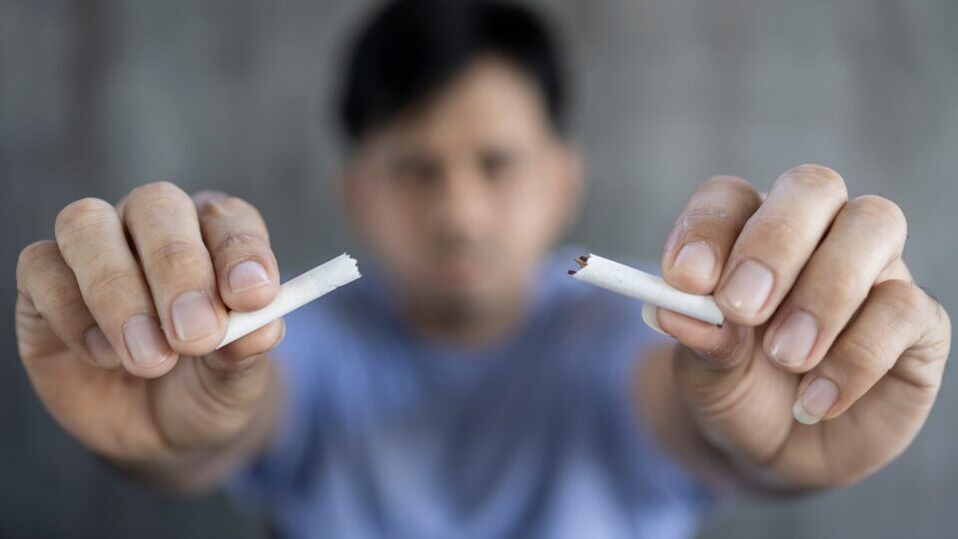Even heavy smokers know that smoking is a bad habit that negatively affects health. Many people dream of quitting smoking, but are afraid of a "withdrawal syndrome". We will discuss how you can quit smoking quickly and effectively in our article.

When we talk about smoking, it is generally more accurate to speak of "tobacco addiction" than "nicotine addiction. "According to the WHO International Classification of Diseases, tobacco addiction is a physiological behavioral disorder based on the consumption of psychoactive substances. True nicotine addiction is just a form of tobacco addiction.
What is Nicotine Addiction?
Nicotine is involved in many biochemical processes in our body. That is why smoking is the cause of the development of more than 40 different diseases. Tobacco smoke contains more than 7, 000 harmful chemicals, as well as carbon monoxide and tissue-damaging free radicals.
More than half of smokers dream of giving up this harmful habit, but before fighting smoking, you need to find out the reason why a person smokes. Doctors classify all reasons for smoking into different types of smoking behavior:
"Stimulation»
This smoking behavior manifests itself in people who believe that a cigarette stimulates them, invigorates them and relieves fatigue. The dependence in such people is psychological in nature and smoking cessation leads to symptoms of vegetative-vascular dystonia and asthenia.
"Cigarette game»
People with this behavior smoke little, often "for social reasons" and no more than 2-3 cigarettes per day. They are more interested in accessories: ashtrays, cigarette cases, lighters, expensive types of cigarettes. Smoking is more of a game than an addiction.
"Relaxation»
It is very difficult for such people to quit smoking. For them, a cigarette is an additional pleasure when relaxing and the situation when smoking should be pleasant and relaxing.
"Support"
This type of smoking is necessary for a person to reduce emotional stress. Such people smoke in moments of shyness, anger, insecurity and in unpleasant situations.
"thirst»
This type is associated with physical dependence on nicotine. A drop in the nicotine level in the blood forces a person to smoke despite all prohibitions. It is this type of smoking behavior that can be considered a true nicotine addiction.
"reflex»
Such smokers smoke reflexively without thinking about the fact that they are smoking. They smoke more often during work, in large quantities and "automatically". Most of the time they cannot explain the reason for smoking.
All of the above types of smoking behavior can occur either in isolation or in various combinations.
Tobacco addiction progresses with increasing smoking experience and goes through 3 stages of development:
- Stage 1 – Initial. A smoker occasionally smokes due to psychological addiction. Physical dependence is not observed at this stage.
- Stage 2 is characterized by the first manifestations of physical dependence on nicotine.
- Stage 3 combines pronounced factors of psychological and physical dependence on nicotine.
To find out if you are addicted to nicotine, answer a few questions:
- Do you smoke more than a pack of cigarettes a day?
- Do you feel like you're smoking within half an hour of waking up?
- When you quit smoking, did you feel a strong urge to smoke again and did you suffer from "withdrawal symptoms"?
If you answered yes to all 3 questions, you are heavily addicted to nicotine.
The cause of addiction is nicotine itself, which reaches the brain within 7 seconds after the first inhalation of tobacco products. There, nicotine interacts with nicotinic receptors and promotes the production of neurotransmitters, including dopamine. These substances cause nicotine addiction. As soon as a smoker takes a long break from smoking, the level of these substances in the blood decreases and a "withdrawal syndrome" occurs: craving for smoking, anxiety, reduced attention, restlessness and irritability, weakness, malaise and malaise. A person develops cough, insomniaand other somatic symptoms. The duration of such a period can range from several days to several months. That is why doctors recommend those who quit smoking to take special pharmacological drugs.
Interesting facts about smoking
| Fact about smoking | Description |
|---|---|
| Number of smokers worldwide (WHO) | 1 billion people |
| Percentage of smokers by gender | 40% of all men, 9% of all women |
| In which countries is smoking more common? | Kiribati, Montenegro, Greece, Timor |
| In which countries is smoking less widespread? | Ghana, Ethiopia, Nigeria, Eritrea, Panama |
| Illnesses caused by smoking | Baldness, cataracts, early wrinkles, hearing loss, skin cancer, tooth decay, emphysema, osteoporosis, heart disease, stomach ulcers, miscarriages, disorders of spermatogenesis, psoriasis, thromboarteritis obliterans, cancer of more than 15 organs |
| Annual mortality from smoking (WHO) | more than 7 million people (including 1. 5 million women) – one person every 6. 5 seconds |
| Annual mortality from passive smoking (passive smoking) (WHO) | 1. 2 million people (including 64% women and about 65, 000 children) |
| Popular myths about smoking |
|
5 Best Ways to Quit Smoking
Most smokers have tried to quit smoking at least once in their lives. Some were successful, others could not withstand the painful withdrawal symptoms and the attempt was unsuccessful. In addition to willpower, you may need special medication or specialist help.
Tobacco addiction is one of the strongest addictions and develops much faster than, for example, alcohol addiction. That's why treatment is very difficult.
1. Drugs
Doctors use two types of medications to treat nicotine addiction: nicotine replacement medications (NRTs) and medications that do not contain nicotine. These products are suitable for both those who want to quit smoking completely and those who want to reduce the intensity of smoking. However, a positive result can only be achieved after eliminating psychological dependence, and WIP only provides a time delay to solve this problem.
Medicines that do not contain nicotine
Drugs that do not contain nicotine include nicotinic receptor antagonists (NRAs) and atypical antidepressants. However, atypical antidepressants are not officially used to treat nicotine addiction.
Nicotinic receptor antagonists prevent nicotine from interacting with the receptors of the nervous system and smoking cigarettes is no longer fun for the smoker.
ANR is started one week before the expected smoking cessation date and continued for 12 weeks. During the period of 8 to 35 days of treatment, it is recommended to completely avoid cigarettes.
Advantages and disadvantages:
- the duration of treatment with ANR is several times shorter than with NWP; the drugs do not require gradual withdrawal; good therapeutic effect.
- available by prescription; have a complex dosage regimen; many contraindications; Do not take under 18 years or during pregnancy or breastfeeding.
Nicotine substitutes
Nicotine replacement products (NRTs) are designed to deliver nicotine directly into the human body, replacing regular smoking. Such products are available in the form of lozenges, patches, chewing gum, sprays and inhalers. Smoking cessation is achieved by relieving withdrawal symptoms and gradually reducing the dosage of medication.
The time at which nicotine enters the blood and is present in the body depends on the form of the drug. Nicotine patches are applied directly to the skin. The patch releases nicotine for 16-24 hours. Chewing gum, sublingual tablets and sprays work faster, but the nicotine stays in the blood for a significantly shorter time. The fastest-acting remedy is nicotine spray. After application, the effect occurs within 60 seconds.
Advantages and disadvantages:
- ease withdrawal symptoms; suitable for people who do not want to quit smoking completely; Minimum number of contraindications.
- Before use, you must consult a doctor. Must not be used under 18 years of age or during pregnancy and breastfeeding.
2. Psychotherapy

Psychotherapy helps develop a positive attitude and instill skills that can control nicotine addiction. Psychotherapy is most effective when combined with medication. Psychotherapists often use Erickson hypnosis, cognitive psychotherapy and some other techniques. After just 2-3 sessions with a psychotherapist, the patient's need to smoke disappears.
Advantages and disadvantages:
- pronounced therapeutic effect; enhances the effect of drug treatment; Only 2-3 sessions are required.
- requires highly qualified specialists; depends on the patient's motivation.
3. Acupuncture
This method is based on the effect of needles on biologically active points of the body, which helps to relieve withdrawal symptoms and physical cravings after smoking. Most commonly, 3 to 10 procedures are performed in which needles are attached to acupuncture points on the arms and legs. Another popular method is a needle button that is placed under the skin of the auricle for a long time. The moment the desire to smoke arises, the patient presses on it and the desire subsides.
Advantages and disadvantages:
- does not require taking medication; short treatment duration; has no contraindications or side effects;
- requires high patient motivation; You can only trust a highly qualified specialist.
4. Doctor consultation

The first stage of nicotine addiction is psychological dependence. Most often it is associated with the "ritual of smoking". The reason may be the company involved, the association of smoking with a cup of coffee or driving a car. In young people, the start of smoking may be based on the desire to be more mature and independentto act and assume a certain "status" position. In this case, a conversation with a doctor - for example a psychotherapist or a narcologist - can be the deciding factor in quitting smoking. Awareness of harm to health and the help of a specialist will help eliminate the conditioned reflex that causes the desire to smoke.
There are free advice centers whose operators can advise you by telephone at any time of the day and help you find the most effective way to quit smoking. The doctor may recommend various programs and courses to overcome tobacco addiction.
Advantages and disadvantages:
- consulting a doctor increases the effectiveness of any therapy; allows you to avoid using medication if you are highly motivated.
- only helps with weak dependency; A high level of motivation to quit smoking is required.
5. Behavioral therapy
The aim of this package of measures is to create favorable conditions for quitting smoking and to reduce the number of cigarettes smoked. According to statistics, only 3-7% of smokers can quit smoking without the help of specialists and drug therapy. However, by changing your behavior pattern, it is much easier to quit smoking or reduce the intensity.
- Decide whether you want to quit smoking all at once or gradually. If not immediately, plan to gradually reduce the number of cigarettes smoked.
- If you decide to quit smoking immediately, set a date in advance when you will do so. Try to time it to coincide with an event that is meaningful to you. On the eve of this day, smoke twice as much to saturate your body with nicotine.
- If you smoke frequently at work, you should time your quitting habit around your vacation or weekend. Try to find an exit partner.
- If you are quitting smoking gradually, try not to smoke for as long as possible after sleeping and eating. Remove cigarettes, lighters and ashtrays from your field of vision. Try not to smoke in the presence of children, relatives and in society. Frequently visit places where smoking is prohibited.
- Do not buy cigarettes in advance, but try to smoke only half a cigarette.
- If you feel the urge to smoke, do not smoke immediately. An acute desire to smoke lasts 3-5 minutes. Do some exercise or take a light walk beforehand.
- Try to quit smoking regularly for a while: half a day, a day, a few days, etc.
- Go to the gym. Active physical exercise increases the production of pleasure hormones and alleviates withdrawal symptoms.
Advice from doctors for those who want to quit smoking
Nicotine addiction manifests itself on the psychological, emotional and physical levels. According to doctors, strong motivation is the key to success when quitting smoking. Therefore, every smoker should know the harmful effects of smoking and the benefits of quitting smoking.
Most doctors are skeptical about the ability of an "experienced" smoker to quit the habit on their own. Experiments with nicotine replacement therapy drugs are no less dangerous.
The treatment of nicotine addiction should be comprehensive and individually tailored. There are several developed techniques that can effectively combat the problem. Treating an addiction is a serious and time-consuming task. Without the advice and supervision of a doctor, success becomes much more difficult. After assessing the extent of addiction and the characteristics of your body, a qualified specialist will select a treatment regimen that is suitable for you. Only in this case the result will be positive and expected.
Popular questions and answers
After deciding to quit smoking, many smokers begin to research this topic on the Internet. We have selected the most popular questions and addressed them to our expert.
- Why is it so difficult to quit smoking?
Nicotine addiction affects all areas of the human body: psychological, emotional and physical. In terms of the strength of the bond, doctors compare it to alcohol and drug addiction. When you quit smoking, a "withdrawal syndrome" occurs. Relieving these phenomena is the most difficult task. Treatment requires a long-term, comprehensive and professional approach.
- Is it possible to suddenly stop smoking?
When explicitly motivated, this approach to the problem will be most effective. If you are severely addicted, doctors recommend stopping immediately. Nicotine replacement therapy or nicotine receptor blockers can help relieve withdrawal symptoms.
- How does cigarette withdrawal work?
When quitting smoking for several days and sometimes months, symptoms of the so-called "withdrawal syndrome" appear: craving for smoking, anxiety, decreased attention, restlessness and irritability, weakness, malaise and malaise. Cough, insomnia and other somatic symptoms increase.
- When does the desire to smoke disappear?
The strongest desire to smoke occurs within a week. Later, the desire to smoke subsides, but may last for one to several months. Doctors consider an attempt to quit smoking successful if the patient does not smoke for six months.
- Is it OK to smoke sometimes?
There is no "safe" level of smoking. According to statistics, if a person smokes just one cigarette a day, the risk of heart disease or stroke increases by 30-50%. Each "occasionally smoked cigarette" can return a former smoker to the habitcause nicotine addiction.
- Why do people get fat when they quit smoking?
The main reason for weight gain is "stress eating". When you quit smoking, you often snack instead of taking breaks from smoking, which leads to weight gain. Sometimes when you smoke, there is a disruption of the endocrine system, which leads to weight loss. After quittingWith smoking, weight can return to previous levels.

























